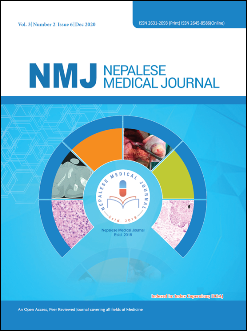Correlation of Arterial Blood Gas Value with Outcome of Patient Admitted with Acute Exacerbation of Chronic Obstructive Pulmonary Disease
DOI:
https://doi.org/10.3126/nmj.v3i2.34880Keywords:
Biomass, Cigarette, Hospital stay, Hypercapnia, Oxygen saturation, Respiratory failureAbstract
Background: The outcome of Chronic Obstructive Pulmonary Disease depends upon the partial pressure of oxygen and carbon dioxide This study was aimed to find the role of arterial blood gas parameters during the length of hospital stay among patients admitted for Chronic Obstructive Pulmonary Diseasewith acute exacerbation.
Materials and Methods: This was an observational study conducted in KIST Medical College Teaching Hospital from February 2017 to August 2019. Patients admitted with the chronic obstructive pulmonary disease were evaluated. Demographic data as well as oxygen saturation (SPO2), pulmonary function test, and arterial blood gas analysis were recorded and analyzed.
Results: Among 112 patients, the female to male ratio was 1.38: 1 with 84.8% over 60 years of age. One-third of patients (n=38) had exposure to both tobacco smoking and biomass and of them, 86.8% were females. Mean SpO2 was 75.9% and mean FEV1 was 0.92 L (SD=0.295) and significant association was found (p<0.001) between them. Furthermore, 70 (62.5%) patients had type I respiratory failure and 42 patients (37.5%) had type II respiratory failure. Patients with type II respiratory failure and hypercapnic patients had prolonged hospital stay with significant p-value (p<0.001). Similarly, significance was observed in the p-value for acidic blood pH, which was <0.05.
Conclusions: Increased length of hospital stay is seen in patients with acute exacerbation of Chronic Obstructive Pulmonary Disease with type II respiratory failure. Hence, aggressive early management to correct hypercapnia may lead to decreased hospital stay along with a better outcome. Thus hypercapnia should be considered as one of the important criteria to flag the patient and manage accordingly.
Downloads
Downloads
Published
How to Cite
Issue
Section
License
This license enables reusers to distribute, remix, adapt, and build upon the material in any medium or format, so long as attribution is given to the creator. The license allows for commercial use.
Copyright on any article published by Nepalese Medical Journal is retained by the author(s).
Authors grant Nepalese Medical Journal a license to publish the article and identify itself as the original publisher.
Authors also grant any third party the right to use the article freely as long as its integrity is maintained and its original authors, citation details and publisher are identified.




